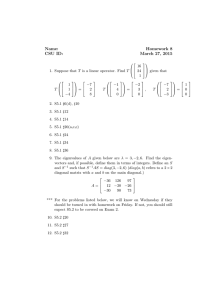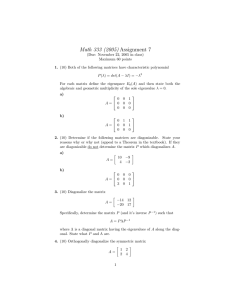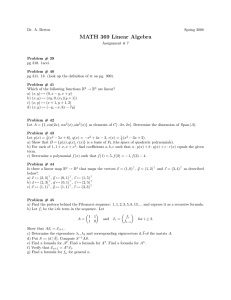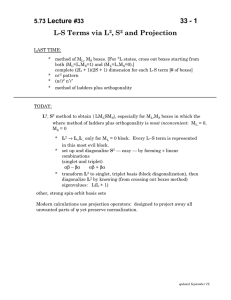( ) ∑ { }
advertisement
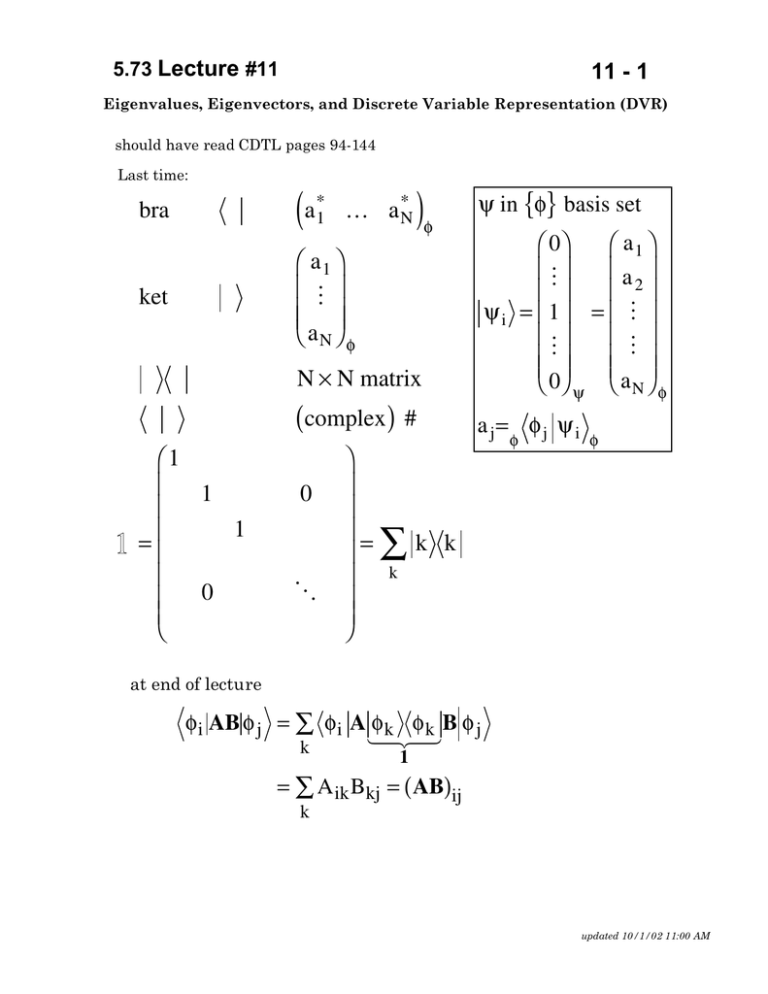
5.73 Lecture #11
11 - 1
Eigenvalues, Eigenvectors, and Discrete Variable Representation (DVR)
should have read CDTL pages 94-144
Last time:
bra
(a
*
1
*
… aN
)
ψ in {φ} basis set
φ
a1
0
a
M
2
ψ i = 1 = M
M
M
0 ψ a N φ
a1
M
aN φ
ket
N × N matrix
(complex ) #
1
1
1
1
=
0
0
O
=
∑k
a j= φj ψ i
φ
φ
k
k
at end of lecture
φ i AB φ j = ∑ φ i A φ k φ k B φ j
1
424
3
k
1
= ∑ A ik Bkj = (AB)ij
k
updated 10/1/02 11:00 AM
5.73 Lecture #11
11 - 2
What is the connection between the Schrödinger and Heisenberg representations?
ψ i ( x) = x ψ i
x 0 = δ( x, x 0 )
eigenfunction of x with eigenvalue x0
Using this formulation for ψi(x), you can go freely (and rigorously) between the
Schrödinger and Heisenberg approaches.
1=
∑
k
Today:
k k =
∫
x x dx
eigenvalues of a matrix – what are they? how do we get them?
(secular equation). Why do we need them?
eigenvectors – how do we get them?
Arbitrary V(x) in Harmonic Oscillator Basis Set (DVR)
updated 10/1/02 11:00 AM
5.73 Lecture #11
11 - 3
Schr. Eq. is an eigenvalue equation
Âψ = aψ
0
a1
a2
A=
O
aN ψ
0
in matrix language
A ψi = ai ψi
1
0
ψ1 =
0
M ψ
satisfies A ψ 1 = a 1 ψ 1
but that is the eigen-basis representation – a special representation!
What about an arbitrary representation? Call it the φ representation.
N
A
c i i φ = a
ci i φ * * *
* * * i =1
i
A as transformation on each φ i
∑
∑
N unknown coefficients {c i }
Eigenvalue equation
i = 1 to N
How to determine {c i } and a ? Secular Eqn. derive it.
first, left multiply by φ j
∑A c
φ
ji i
=a
i
∑c
N
0=
i
j i =a
i
∑ c [A
i
φ
ji
∑c δ
i ij
i
− aδ ij
i =1
]
one equation
N unknowns
next, multiply original equation by φ k
N
0=
∑ c [A
i
φ
ki
i =1
etc. for all
φ
− aδ ik
]
another equation
.
N linear homogeneous equations in N unknowns – Condition that a nontrivial
(i.e. not all 0’s) solution exists is that determinant of coefficients = 0.
updated 10/1/02 11:00 AM
5.73 Lecture #11
11 - 4
A11 − a
A12
…
A 22 − a
O
A 21
0=
A1N
A NN − a
Nth order equation – as many as N different values of a satisfy this equation (if
fewer than N, some values of a are “degenerate”). Does everyone know how to
expand a determinant?
{ai} are the eigenvalues of A
(same as what we would have obtained by
solving differential operator eigenvalue
equation)
If we know the eigenvalues, then we can find the N { ψ i
ψi =
∑
cj j
j
φ
} such that
expand the eigenbasis in
(computationally convenient) basis
ψ i Aψ ψ j = a jδ ij
0
a1
Aψ =
0 O aN
A ψ ψ1
1
0
= a1
0
M
But we generally start with Aφ in nondiagonal form
computer
1.
2.
3.
transform to diagonal form by T ≤ Aφ T = A ψ
the diagonal elements are eigenvalues
the diagonalizing transformation is composed of eigenvectors,
column by column of T ≤ .
updated 10/1/02 11:00 AM
5.73 Lecture #11
11 - 5
Hermitian Matrices
A = A†
A†ij = A*ji
(can use this property to show that all expectation values of A are real)
These matrices can be “diagonalized” (i.e. the set of all eigenvalues can be
found) by a unitary transformation.
T −1 = T ≤
unitary matrix
0
a1
a
2
≤ φ
≡ Aψ
diagonalization T A T =
O
diagonal
not diagonal
0
a
N ψ
≤
φ
≤
T A TT φ j
diagonal Aψ
Eigenvector
expressed in
φ basis set
updated 10/1/02 11:00 AM
5.73 Lecture #11
11 - 6
0
0
T1≤i
M
M
≤
T
T ≤ φ i = T ≤ 1 = 2 i = ψ i = 1 ← i - th position
M
M
M
≤
i-th
TNi φ
position
0 φ
0 ψ
eigenvector
i-th column
of T†
suppose we apply
Aψ ψ i
0
M
= Aψ 1
M
i-th
0
ψ
0
M
= ai
M
0
ψ
0
M
= ai 1
M
0
ψ
RECAPITULATE:
Start with arbitrary basis set φ
Construct Aφ : Not Diagonal, but basis set was computationally convenient.
a1 0 0
= Aψ
O
Find T (computer) that causes T A T =
aN
0
≤
φ
Eigenstates (eigenkets) are columns of T ≤ in φ basis set.
Columns of T are the linear combination of eigenvectors that
correspond to each basis state. Useful for “bright state” calculations.
updated 10/1/02 11:00 AM
5.73 Lecture #11
11 - 7
Can now solve many difficult appearing problems!
Start with a matrix representation of any operator that is expressable as a
function of a matrix.
e.g.
e − iH( t −t 0 )/h
propagator
f ( x)
potential curve
,
prescription example
f ( x ) = Tf (T† xT)T†
123
x1
†
T xT =
0
diagonalize x – so f( ) is
applied to each diagonal
element
x2
0
O
xN
f (x1 )
0
f (x 2 )
†
f (T xT) =
O
0
f (x N )
Then perform inverse transformation T f(T† x T)T† – undiagonalizes matrix, to
give matrix representation of desired function of a matrix.
Show that this actually is valid for simple example
f(x) = x N
f(x) = T T†xT T†xT L T†xT T†
[(
[
1
† N
)(
]
2
†
) (
= T T x T T = xN
N
)]
apply prescription
get expected result
general proof for arbitrary f(x) → expand in power series. Use previous result
for each integer power.
updated 10/1/02 11:00 AM
5.73 Lecture #11
11 - 8
John Light: Discrete Variable Representation (DVR)
General V(x) evaluated in Harmonic Oscillator Basis Set.
we did not do H-O yet, but the general formula for all of the nonzero matrix
elements of x is:
1/2
h
n x n +1 =
2ωµ
(infinite dimension matrix)
x 2 = h
2ωµ
1/2
( n + 1)1/2
ω = (k µ)
1/2
h
x=
2ωµ
1
0
2
0
2
0
3
0
6
0
5
0
0
0
0
0
0
0
0
0
0
0
12
0
0
0
0
0
1
0
1
0
2
M
M
0
6
0
7
0
0
0
0
0
2
L
L
3
M
0
3
M
M
0
4
L 0 0
L 0 0
0 = 0 0
4 0 0
0 0 0
0
0
0 0 0 0
12 0 0 0 0
0
0 0 0
9
0
0 0
0 11 0
0
0 13 0
0
0 15 O
0
0
O O
0
0
0
0
0
0
0
0
0
0
0
0
0
0
0
0
0
0
0
[CARTOON]
etc. matrix multiplication
to get matrix for f(x) diagonalize e.g., 1000 × 1000 (truncated) x matrix that was
expressed in harmonic oscillator basis set.
updated 10/1/02 11:00 AM
5.73 Lecture #11
x1
0
T†xT =
0
0
11 - 9
0 0
0
x2 0
0
0 O
0
0 0 x 1000 x
diagonalized-x basis
{xi} are eigenvalues.
They have no
obvious physical
significance.
0
0
0
V( x 1 )
0
0
V( x 2 ) 0
V( x ) x =
0
O
0
0
0
0
0 V( x 1000 )
full
†
V( x ) H − O = TV( x ) x T = complicated
matrix
H=
next transform back
from x-basis to
H-O basis set
x
1000
T was determined
when x was
diagonalized
× 1000
H−O
p2
+ V(x)
2µ
need matrix for p2, get it from p (the general formula for all non-zero
matrix elements of p)
updated 10/1/02 11:00 AM
5.73 Lecture #11
11 - 10
1/2
h(ωµ)
1/2
n p n + 1 = −i
n
+
1
(
)
2
0
1
0
0
2
1/2 − 1
h(ωµ)
p = −i
− 2 0
0
2
0
O
0
0
O
0
−1 0
2 0
0 −3 0 O
h(ωµ)
p2 = −
2 0 −5 0
2
0 O O O
0 O O O
if
H=
p2 1 2
+ kx
2µ 2
2
hω 0
H=
4 0
0
0
0 0
0 0
O O
O O
0
0
O
O
0
same structure as x
1 k = 1 ω 2 µ
2
2
0
0
0
1 / 2
0 0 0
0
0
6 0 0 = hω 0 3 / 2
0 10 0
0
0
5
/
2
0
0 0 14
0
0 O
0
but for arbitrary V(x), express H in HO basis set,
2
pHO
H HO =
+ V( x ) HO
2µ
TV(x)xT†
E1 0 0
eigenvalues obtained by S H HOS = 0 O 0
0 0 EN
†
columns of S† are eigenvectors in HO basis set!
updated 10/1/02 11:00 AM
5.73 Lecture #11
11 - 11
1. Express matrix of x in H-O basis (automatic; easy to program a
computer to do this), get xHO.
2. Diagonalize xHO. Get xx and T.
3. Trivial to write V(x)x as V(xi) = V(x)x in x basis
4. Transform V(x)x back to V(x)HO
5. Diagonalize HHO.
Solve many V(x) problems in this basis set.
1000 × 1000 T matrix diagonalizes x ⇒ 1000 xi’s
Save the T and the {xi} for future use on all V(x) problems.
To verify convergence, repeat for new x matrix of dimension 1100 x 1100. There
will be no resemblance between {x i}1000 and {x i}1100 .
If the lowest eigenvalues of H (i.e. the ones you care about) do not change (by
measurement accuracy), converged!
Next: Matrix solution of HO (no wave functions at all)
Start from Commutation Rule!
Then Perturbation Theory.
updated 10/1/02 11:00 AM




